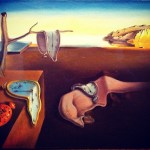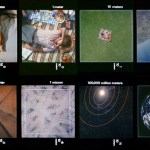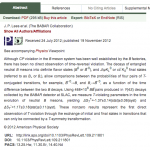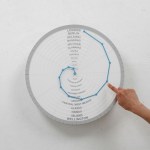Time
Image of Cricetomys gambianus from Wikipedia.
In a newly published study from Physiological Reports, researchers were interested in learning more about the basic physiology of African giant rats (Cricetomys gambianus). According to the study, heart rate is one of several "physiological constants" that offer a clue into how an animal might interact with its environment as heart rate may be influenced by season and patterns of food consumption among other variables. This particular species of rat is of interest as they are often kept as exotic pets while others …
Walking on two legs, time and space seem universal, but take a good look at the universe, and things start to get mushy. Chad Orzel defines time with a circular-sounding title, writing “there isn’t a giant master clock at the center of the universe that everybody sets their watches by.” Although time can only be measured in ticks, two clocks are seldom in agreement. Chad says “Scientists in Colorado have clocks so good they can measure the change in time from moving at walking speed, or from moving one foot higher in elevation.” On Starts With a Bang, Ethan Siegel revisits the speed of light…
What is distance?
There's the distance between people, who subconsciously space themselves apart, providing a reliable visual matrix of intimacy. It's no coincidence we use the word "close" to describe our most intimate relationships: to whisper and caress, we draw near to one another, less than six inches apart. For chatter amongst personal friends, the norm ranges from 1.5 to four feet. The more estranged, the farther away we shrink. Social distance for interactions among acquaintances overlaps with the previous category, but ranges outwards to nearly twelve feet. Of course, we don't always…
BaBar data recently analyzed might confirm that time is wibbly wobbly timey wimey stuff.
If you are a B meson, time may not run the same in both directions for you. This is based on a report in Physical Review Letters called "Observation of Time-Reversal Violation in the B0 Meson System" which has this abstract:
I had to use a screen shot because I can't type in all that wiggly wobbly formula stuff.
Nature Blogs's Eugenie Samuel Reich explains this HERE. If that is not clear, just watch this video:
"The moon shuts off the beams of the sun as it passes across it, and darkens so much of the earth as the breadth of the blue-eyed moon amounts to." -Empedocles, ~450 B.C.
Less than two weeks ago, I saw my first annular eclipse, with some spectacular results at the moment of maximum eclipse.
From my first eclipse expedition, to False Klamath Cove, on the coast in northern California.
This happens, of course, because -- from our point of view -- the Moon appears to pass in front of the Sun, blocking a fraction of the light coming from it.
Image credit: NASA / Solar Dynamics Observatory.
And…
Is poetry a driving force of Oceanography?
Read Rimbaud!
- Phillipe Diolé
I've written many times, although not recently, about the ocean.
When I first began Universe in 2005, it was practically a ship's log: meandering pieces on narwhal tusks, the accidental poetics of my hero, Rachel Carson, and adolescent screeds on the perils of the Mariana trench. At some point in my career, I ported my energies outward to the cosmos, reasoning, as the ancient alchemists did, that "As Above, So Below."
The movement from the deep to the distant, from sea to space, seemed like a sensible evolution.…
In 1977, NASA sent a pair of unmanned probes named Voyager 1 and Voyager 2 into space. Among the infrared spectrometers and radio receivers included on each probe were identical copies of the same non-scientific object: the Voyager Golden Record.
Sheathed in a protective aluminum jacket, the Record is a 12-inch gold-plated copper disk containing sounds and images chosen to portray the diversity of life on Earth: bird calls, whale songs, the sounds of surf, wind, and thunder, music from human cultures, and some 55 greetings in a range of languages, alive and dead. Like lonely time capsules,…
The US spends far more per capita on healthcare than any other developed country -- $7,538 per person, compared to $3,129 in the UK, $4,079 in Canada, and $5,003 in Norway (the second-biggest spender), according to 2008 totals compiled by the Kaiser Family Foundation. One contributor to our high healthcare costs is high administrative costs, which is the natural consequence of having hundreds of different insurance plans with different policies, networks, and rates. A new study in the journal Health Affairs focuses on one aspect of administrative costs: the time physician practices spend…
We shared two cherry tomatoes this morning, the first ripe ones of the year, and that, to us, is the proof we're fully into high summer. If I don't pick the zucchini every day, I'm sorry. The weather is hot and sultry, the apricots are close to ripe and the peaches are following. The boys drown in fruit every day - it is the one thing I can't say no to. The fireflies sparkle like fireworks. The kids live in the creek and under the sprinkler, and seem to stretch out daily, getting taller, stronger, learning new things. Tonight we're headed to a baseball game (local minor league) - what…
A month and a half ago, I reported on a simple experiment to measure the performance of a timer from the teaching labs. I started the timer running at a particualr time, and over the next couple of weeks checked in regularly with the Official US Time display at the NIST website, recording the delay between the timer reading and the NIST clock.
As a follow-up experiment, I did the same thing with a different timer, this one a Good Cook brand digital timer picked up for $10 in the local supermarket, and the same Fisher Scientific stopwatch/timer as the first experiment, with the Fisher…
A scientific theory hasn't really arrived until the cynical and unscrupulous find a way to use it to extract money from the credulous and gullible. This has posed a significant obstacle for general relativity, dealing as it does with gravity, which requires really gigantic masses to produce measurable effects. That makes it a little difficult to sell wacky general relativity-based schemes to people.
Until now, anyway-- recent advances in atomic clocks have made it possible to see relativistic effects on a human scale. There was a really nice talk on this experiment in the fundamental symmetry…
One of the tensions in my life -is that between two kinds of time. "Fast Time" is the world I live in, the one with a two hour meeting scheduled at 7pm, my husband's classes at 12:35, Eli's bus at 8:15 and 3:30... payments due by the first of the month, etc... It is the world run on clocks and calendars, where expectations can be fixed and formalized. All of us live in fast time in some measure, some of us almost completely, others only barely. There is, however, no good way of escaping it entirely.
I also live in slow time. Slow time is the world of things that cannot be subject to…
SteelyKid is a big fan of the classic children's book Goodnight Moon, which, if you haven't spent the last sixty-odd years in a cave, you probably know features a bunny saying goodnight to a variety of objects in a great, green room. The attentive toddler will find a lot to look at in the pictures-- there's a mouse in every one that SteelyKid delights in pointing out-- but an inquiring adult might well ask "Just how long does it take this bunny to say goodnight to all this stuff, anyway?"
Well, we can answer this question with SCIENCE! You see, there are six pictures in the book showing the…
Let's define alien.
Definition number one: unfamiliar. By that description alone, a good 99% of life on this planet is alien. Breathing water, living nestled in thermal vents, stalking prey on the veldt, growing out of the Earth and eating sunlight, without eyes, without legs, with extra legs, color-blind, carapaced, marsupial, with exoskeletons, with jelly for brains, microbial, in a test tube, growing from spores. Not to mention the extremophiles, those nutty organisms that thrive in hellish environments like boiling acid, liquid asphalt, radioactive waste, and under extreme pressure.
I'…
The theory of relativity takes its name from a very simple and appealing idea: that the laws of physics should look the same to moving observers as to stationary ones. "Laws of physics" here includes Maxwell's equations for electricity and magnetism, which necessarily means that moving observers must see the same speed of light as stationary observers (Einstein included the constancy of the speed of light as a second postulate in his original relativity paper, but it's redundant-- the constancy of the speed of light is a direct consequence of the principle of relativity). This leads directly…
Dezeen Magazine has the drop on this superb clock that shows the time in every time zone, using just one hand.
The clock is called Bent Hands and is designed by Giha Woo and Shingoeun.
Via Neatorama
tags: The Secret Powers of Time, time, hedonism, future orientation, education, personality type, popular psychology, society, culture, lucifer effect, teenage pregnancy, Philip Zimbardo, Royal Society of Art, RSA, streaming video
In this video animation, Professor Philip Zimbardo conveys how our individual perspectives of time affect our work, health and well-being. Time influences who we are as a person, how we view relationships and how we act in the world.
Learn more about RSA Animate.
Professor Philip Zimbardo conveys how our individual perspectives of time affect our work, health and well-being. Time influences who we are as a person, how we view relationships and how we act in the world.
DAYDREAMING is a critical component of conscious experience. The mind can perform mental time travel - it occasionally strays from the present moment, to recollect an experience from the near or distant past, or to imagine an event that has not yet taken place. We know that thinking about the future is dependant on memory, because patients with amnesia cannot imagine new experiences. It involves piecing together fragments of past experiences to generate a plausible simulation of what might happen. This may have been an important development in human evolution, as it enables us anticipate a…
From William Leeman but found via SkepChick, in turn found via The Penguin.
(If you've never read Time considered as a helix of semi precious stones you should; though it isn't quite as good as its title).
While I'm here, do you fancy some of that John "wacko" Donne?
BATTER my heart, three person'd God; for, you
As yet but knocke, breathe, shine, and seeke to mend;
That I may rise, and stand, o'erthrow mee,'and bend
Your force, to breake, blowe, burn and make me new.
I, like an usurpt towne, to'another due,
Labour to'admit you, but Oh, to no end,
Reason your viceroy in mee, mee…







